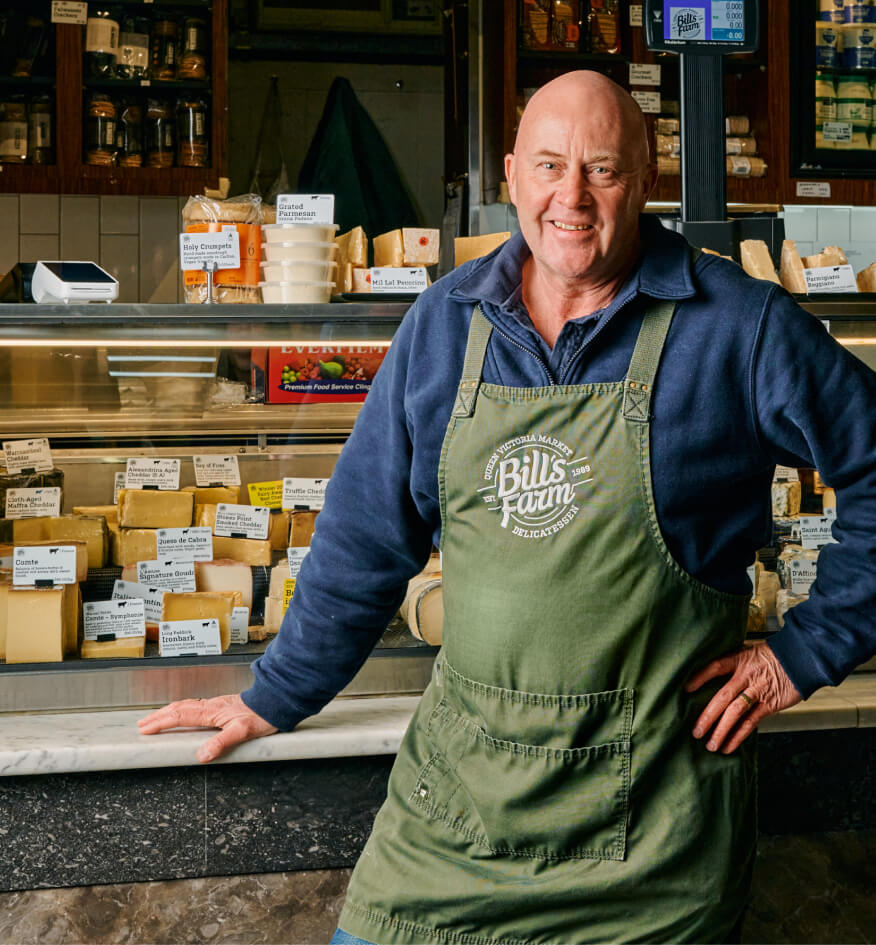Introducing Zeller for Startups.
Don’t waste time assembling disparate tools or waiting in line at a bank. Zeller for Startups is an all-in-one financial solution for founders, by founders.

Don’t waste time assembling disparate tools or waiting in line at a bank. Zeller for Startups is an all-in-one financial solution for founders, by founders.

Speak to our expert team about your in-store payments, and we’ll personalise a solution to your business and budget.

Enjoy a free, built-in POS system with the new Zeller Terminal 2. Order today with free express shipping nationally.

Starting a new business? Enjoy a free, built-in POS system with the new Zeller Terminal 2.
This year, Australians are grappling with belt-tightening inflation, the likes of which we haven’t seen in three decades. How small business owners respond to soaring supply costs, continued staff shortages and customers with diminishing spending capacities will determine whether they survive or thrive.
We surveyed hundreds of Australian business owners, and spoke in depth to some, to better understand their concerns, and how they’re overcoming the challenges. The Zeller Small Business Resilience Report presents and gives context to the most common pain points, dispels any misconceptions, and provides a tangible list of solutions and opportunities to curb the crunch and drive your business forward amid a challenging economy.
Zeller research shows that the three most concerning areas for small business owners today are increasing supply costs, reduced consumer spending, and continuing challenges in finding and retaining staff. Before we explore how to mitigate the effects of these problems, it’s important to understand the interplay between all three.


While supply costs have increased across the country, many Australian business owners are concerned that their costs have increased at a rate that is much greater than that of inflation. Zeller research show a staggering 80% of business owners estimated that their supply costs had increased by more than 10% in just one year, while 1 in 5 estimate their costs had gone up between 20 and 50%.
Speaking with business owners across the country, from Sydney’s affluent suburb of Mosman to the South Australian coastal town of Victor Harbor, to central Melbourne, the message is clear: everything has increased in price.
Michelle and Vass from Miss Jaffles in Cronulla, NSW opened their cafe in 2021. Since then, they’ve seen supply costs surge, “There’s not one thing that hasn’t gone up” explains Vass. Two years ago 15 dozen eggs cost them $38, today, that price has increased by 79% to $68. Loaves of bread were once $2.90 each; now they are $4, a 38% increase. When asked whether their suppliers had given a reason for the price increase, they say no, and are sceptical whether such an significant markup is entirely justified.
Similarly, Matt Bisaro from Floral Craftsman in Mosman, NSW doesn’t think the inflated supply costs were warranted. “It’s increased tenfold since COVID. I put it down to greed… Obviously the cost of freight increased, but my belief is that once someone realises that they can get more for it… they’ll just keep it the same.” 1,400 kilometres away in Victor Harbor, South Australia, Kirsten Pitman, owner of two restaurants and deputy chair of the local chamber of commerce shares the same opinion, “Part of me wonders whether maybe larger companies are going for a cash grab.”

Matt Bisaro, Floral Craftsman, Mosman, Sydney
Understanding the cause of a price increase is key when figuring out what to do about it.
Just like you, your suppliers’ margins are also being squeezed as a result of increased costs for freight or raw materials. However, if your supplier contacts you to inform you of a price increase, you can ask for justification. Don’t always accept “inflation” or “COVID” as a blanket rationale.
Request a price / cost breakdown. This will help you understand where your money is going and ensure you are getting the best possible value for your purchase. It should include direct costs, indirect costs, administrative costs, and profit margins.
Once you have these answers, you’ll be better positioned to think about whether or not it’s worth looking for another supplier or whether there is room to negotiate.
With a price / cost breakdown from your supplier, you can see whether you have room to negotiate. If you haven’t, you’re going to have to find that out by testing the water. Some key tips to negotiating:
Ask yourself the following questions:
If you answered yes to one or more of these, then it’s possibly time to consider increasing your prices.
If you’re worried about customer backlash, having something to help justify the price increase can soften the blow. Offer a free feature or incentive, bundle your products or services together, or add new services or products. Otherwise, honesty is the best policy. Publish your price increases on your website or clearly update your price labelling in-store. When notifying your customers of a price increase, always be transparent and allow them to make their own informed decisions.
Malcolm McCullough from Bill’s Farm at Melbourne’s Queen Victoria Market has increased prices on roughly half of his products in line with inflation.

Malcolm McCullough, Bill’s Farm, Melbourne
The benefits of local suppliers include fast delivery, knowledge of local markets and customers, fast communication, and less negative effects on the local environment. Overseas suppliers may offer more choice and lower production costs, however with these you may also incur shipping costs and delays, import requirements and regulations, and warehousing costs.
When it comes to finding suppliers, Kirsten Pitman knows the importance of investing back into the local economy.
How stable and reliable is the supplier?
You’ll need to be clear on their terms and conditions including how quickly they can ship, and whether they will always have what you need in stock. Research whether they’re financially stable and how long they’ve been in business. Most importantly, look for recommendations from other businesses.
Customers are becoming increasingly discerning when it comes to buying products made at great cost to people or the environment. Choosing a supplier that is reducing their carbon footprint and is providing a safe and fair workplace for their staff is not only the right thing to do, but it can help you win even more customers who want to spend their money responsibly and sustainably.

Nino’s of Victor Harbor, South Australia
Understanding your costs is one of the most important things you can do as a business owner. “Don't get caught out assuming you're making money without really checking… it's very easy to get caught up and you don't realise for months and months” recommends Kirsten.
Malcolm McCullough has replaced his traditional business bank with Zeller, for nearly all of his financial needs. Using the Zeller Transaction Account and Debit Cards allow him to keep all his expenses visible and easily trackable, “We look at [the Zeller Dashboard] every week. We know exactly where our profit is going to finish at the end of the financial year… and then we'll forecast for the next financial year and measure [our sales] every week to see how we're going against that budget.”
Having a clear view of your expenses will allow you to quickly identify what’s costing you the most, and where there is opportunity to cut back.
Kirsten is one of thousands of Australian business owners who has turned her back on the banks in favour of Zeller to significantly reduce her merchant fees, “[With the bank] my costs for five terminals across my three locations were in excess of $5,500 a month. So I said enough is enough.” Thanks to the savings she is now making with Zeller, Kirsten has managed to wear much of the increased supply costs, and has kept her prices the same. “We haven't increased our prices because I've saved so much money with our EFTPOS, so I feel like that's actually played into our favour in this current environment. I haven't had to put that 5% up on everything.”
In Australia, businesses are legally entitled to charge customers a fee for processing a card payment. Passing these fees onto the customer is known as surcharging, and a growing number of Australian merchants are adopting the practice. John and Cheville from West Street Fruits in Melbourne’s outer suburb of Hadfield are saving their business thousands of dollars a year by surcharging. At one point, their bank fees were so high, “they were equivalent to mortgage repayments” Cheville explains. While the practice still remains most common among hospitality businesses, retail is beginning to catch on too. Matt Bisaro noticed some push back when he originally started surcharging at his florist, but has seen a swift change in attitude, “Now you can add on that surcharge and no one thinks about it, cause everyone's doing it.”
Zeller Merchants Surcharging – Increase by Transaction Volume
Faced with the combined pressure of inflation and multiple interest rate rises, Australian consumers are now showing signs of slowing their spending. In January, households were spending 17.8% more than they were the same time last year, however this decreased month on month, down to 6% in April.
Average Household Spending Growth
Index values are based on January 2019 as the reference period (January 2019 = 100)
Source: Australian Bureau of Statistics, Monthly Household Spending Indicator, April 2023
Australia is a country of 26 million people, living across vastly different social and geographical landscapes. So, while the data show that average Australians are reducing spending, individuals will respond to the cost of living pressures in different ways depending upon their own unique set of circumstances. By understanding your customers, you can gauge these circumstances before adjusting your strategy.
Michelle and Vass work in their Cronulla cafe seven days a week. Not only have they noticed a downward trend in their average transaction value, they’ve also spoken to their regulars about the interest rate hikes. “We have a lot of people who are homeowners… they’re struggling.” Rather than passing their own increasing costs onto the customer, the two owners have found success in offering specials “We have a $10 special that just flies out the door.”
Similarly in Hadfield, the locals buying their fruit and vegetables at West Street Grocer are reaching for the bargain bin, “We're seeing a lot of our markdown stuff go a lot quicker” says Cheville.
The other side of the coin however, is that many of those who have remained relatively unscathed by the cost of living crisis have left to go travelling, “This is the first year for ages people have been able to travel internationally, so many have done just that!” says Kirsten Pitman.
It's a trend that’s also affecting Matt in Mosman, “I’ve tried to bring in more, and increase sales [rather than putting up prices], but that is not going to plan now that everyone's travelling… half of Sydney is on a plane to Europe.” Operating in an affluent area of Sydney, Matt doesn’t believe his sales are greatly affected by interest rate rises, “I think I'm in a bubble here. I don't think it impacts this area as much as it's impacting down south or out west... These are CEOs and CFOs with a higher earning capacity.”
Between those who can still afford to jet off on holiday, and those who are having to tighten their belts, Australians aren’t all responding to the cost of living crisis in the same way. It’s important not to make blanket assumptions about what your customers can and can’t afford. Rather than adjusting your prices or your product or service according to what you think will accommodate their spending capacity, you need to firstly understand what that is.
Getting to know your customers personally is not only one of the best ways to win their loyalty, but it gives you an insight into the issues that are impacting them, and therefore, your business.
Having a payments platform that gives you a clear visualisation of the volume and value of your transactions over time is one of the best ways to recognise trends in your customer spending. With Zeller Dashboard, you can track your daily and monthly sales totals, together with a graph depicting the total value of sales collected over the last 30 days. If your business has multiple locations, you can also see performance per site, which will help you to understand whether reduced consumer spending is more noticeable in one location over another.
Take note of customer behaviour within your business by paying attention to the types of products they are purchasing, their reactions to prices, and any signs of hesitation or affordability concerns. Offering a special deal is a great way of gauging whether your customers are looking to cut their spending.
Having the possibility to pull contact-based reports will ensure you’re nurturing your best customers. Zeller’s Contact Directory enables you to identify your top spenders (via EFTPOS machine payments) or top clients (via online invoicing) to ensure that you’re catering to their needs, offering them exceptional service, and driving repeat patronage.
With thirty five years’ experience in retail, Malcolm McCullough says there’s only three ways you can increase sales, “Either you get more customers and you sell the same, you sell more to the same amount of customers, or you put your prices up. They're the only three ways.”
If you’d asked any small business owner last year what their biggest concern was, it’s certain that staff shortages would have been their most pressing issue.
While there has been an easing of staff shortages in some industries, finding skilled employees and keeping good staff remained the third biggest concern for survey respondents.
The owners of Miss Jaffles both work seven days a week, they haven’t yet found any full time staff who they can trust with managing the business, and not for a lack of trying. They blame the significant handouts that helped hospitality workers through the pandemic, “[JobKeeper] was like $700 a week which is more than what they’d be getting if they were only working 2-3 days a week. So nobody wanted to work and still nobody really wants to work” says Michelle. Vass agrees, “Someone actually admitted to that. They said why would we come and work if we can get it for free?”
This changing attitude towards work brought on by the pandemic is not the only one. For Kirsten Pitman, she puts it down to a growing appetite for jobs with flexible work-from-home benefits, “I think there’s been a shift away from public-contact jobs… I think we've had a lot of people leave [hospitality] in favour of other jobs that are not so much in contact with people.”
Kirsten has had to increase wages by roughly 20% over the last 18 months but believes businesses are starting to put the brakes on a bit. “Our staff costs have increased dramatically but I feel like we’re getting to the other end of that… It’s the middle of winter, businesses are looking at their wage costs going ‘we're not actually making any money here.’”
Meanwhile in floristry, Matt Bisaro is struggling to hire for an entirely different reason. “It's really hard to find good staff and more so now because of social media. In this industry everyone thinks they'll do a course and then become a freelancer… 10-15 years ago it was very different, we had portfolios, but now it's all on your social media feeds.”
Between rising wage costs, people transitioning to flexible work-from-home arrangements, or the rise in freelance opportunities brought about by social media, the labour landscape has become more competitive, and businesses are going to have to change their tactics.
How Small Business Owners Are Coping with Staff Shortages
Malcolm from Bill’s Farm recounts, “One of our staff started with us as a casual, then went to part time, she's now full time, and she's also the person who is going to run the store while we're on holidays. So she's been trained to do more and she's going to get paid appropriately.”
Recognise the valuable members of your team and ensure they know that you appreciate their contribution with both verbal and tangible recognition. Review their wages, and look for opportunities for them to grow and upskill within the business.
From Cronulla to Mosman, Hadfield and Melbourne, every business we spoke to had had success finding staff through word of mouth. If you’re looking for employees, make sure your friends, family and customers know about it. Utilising your network doesn’t cost you anything, plus, if candidates are coming with a recommendation, it’s more likely they will be competent and reliable.
Not only is it more cost-effective, but investing in young or less experienced employees can be a long-term investment. Michelle and Vass have hired two teenagers at their Cronulla cafe, “We don't mind hiring the young ones because you can train them the way that you have been taught yourself, they’re not coming in with any bad habits… They also pick up the POS in about half a day because they’re so tech savvy!”
By providing training, mentorship, and growth opportunities, employers can nurture the next generation of business leaders and ensure they have skilled, trustworthy individuals in the future.
Malcolm from Bill’s Farm uses Zeller to track his sales in order to identify busy periods to help him manage his rostering. “The Zeller Dashboard lets you compare what comes through EFTPOS from one week to the next… So if transactions are varying at a certain time of day, it means that we've got a requirement for less people or more people. So we look at our rostering around it. It provides us with information about when those transactions are happening.”
Payroll typically represents the largest expense for many small businesses, so ensuring that your staff are being rostered on when sales are at their peak, is an important way to optimise your revenue.
While the hurdles brought about by inflation, rising interest rates and labour shortages will continue to test a lot of small businesses this year, they will also serve as the impetus to reevaluate your business operations for the better. Whether it’s finding new suppliers, promoting staff members or overhauling your financial system to better monitor your sales and expenses, 2023 can still be a pivotal year for business growth.
At Zeller, we understand the challenges facing small business, which is why we’ve worked hard to create a solution. From EFTPOS to invoicing, debit cards and reporting, our financial ecosystem has been built to help businesses take payments, make payments, and manage their money — better than a business bank. The world is changing, and so should the way you do business.
